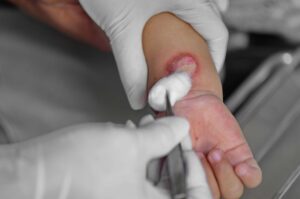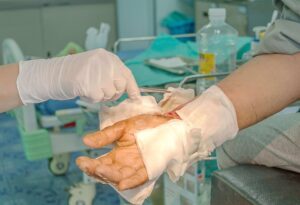Burn wounds are a common occurrence for everyone. Be it contact with flame, chemicals, electricity, or wet sources like steam or hot water, burns can happen at any time. Therefore, it is critical to understand emergency management for burns and be aware of safety measures to ensure quick recovery in case of an accident.
Small burns are often not life-threatening, but larger burns can impose a significant risk in addition to being extremely painful. According to a recent review “Acute thermal injuries requiring medical treatment affect nearly half a million Americans each year, with approximately 40,000 hospitalizations and 3,400 deaths annually.”
 When examining burns, wound care specialists prioritize critical patients by classifying the type of burn and stabilizing the patient, cleansing, and debridement to prevent infections and focusing on full functional recovery.
When examining burns, wound care specialists prioritize critical patients by classifying the type of burn and stabilizing the patient, cleansing, and debridement to prevent infections and focusing on full functional recovery.
It’s important to be able to recognize the severity and type of burn you have, so you not only know when it’s time to seek professional support but also how to care for your wound at home.
Types of Burns
Burns can be classified based on how deep they penetrate the skin’s surface and the size of the burn.
- First-degree burns are superficial burns where only the top layer of the skin i.e. the epidermis is damaged. This includes wounds such as mild sunburns, whereby the skin appears red, and feels painful but there are no blisters.
- Second-degree burns or partial thickness burns, burn through your epidermis and dermis – the first two layers of skin. Occurring due to a range of causes like flames and chemicals, they can either be superficial where only a part of your skin is damaged or deep-partial thickness where the dermis is severely impacted. These burns are not only painful but may present with blisters.
- Third-degree or full-thickness burns are more serious, can result in scarring, and carry a higher risk of infection. They burn through every layer of skin. Third-degree burns can cause the skin to appear gray, black, or white and have a leathery appearance. In some cases, these types of burns damage nerve endings so you might have difficulty realizing how serious it is without professional help.
- Damage to the muscles and bones changes the classification to a fourth-degree burn that is even more severe and requires prompt medical attention.
It’s important to note that it is possible to suffer from more than one level of burn depth. As such, multiple approaches to wound management might be necessary. Your wound care specialist will perform an initial assessment to evaluate your burn and determine the appropriate treatment plan.
Wound Care for First-Degree Burns
 First-degree burns are common and though you can typically care for them at home, it is always better to have a wound care specialist take a look at the injury and guide you on its management. Seeking professional guidance is even more pertinent in cases where the injury has occurred on your face, genitals, hands, or feet.
First-degree burns are common and though you can typically care for them at home, it is always better to have a wound care specialist take a look at the injury and guide you on its management. Seeking professional guidance is even more pertinent in cases where the injury has occurred on your face, genitals, hands, or feet.
Through proper wound care, most minor burns commonly heal within a week or two. Below are a few helpful tips for managing a minor burn and helping it heal:
- Remove constrictive clothing and objects: Any tight clothing, jewelry or belts should be gently taken off as fast as possible, before the burn results in inflammation.
- Cool the burn: Place the burnt area under cool running water. Avoid applying ice directly, as that can exacerbate the injury and damage tissue. A wet compress can also be used to help with any pain.
- Apply lotion or ointment: It is important to keep burns moisturized so the skin can retain elasticity, move easily and prevent dryness. Look for lotion or ointment that contains aloe vera or moisturizer to soothe the wound and prevent drying. Petroleum-based ointments can also be used to provide relief.
- Apply bandages: This step can help further protect the burn against infections. You can use a sterile gauze, cloth, or non-adhesive bandage to cover the burn loosely, as applying pressure could increase pain. Fluffy cotton should be avoided. Bandaged wounds prevent air with micro-organisms from reaching the burnt skin, help reduce pain, and protects blisters.
- Additional Tip: blisters that occur after a superficial burn help protect against infection so try to avoid breaking them. If it does happen clean the area with water and apply ointment.
- Over-the-counter pain medication: Medications such as Tylenol, Panadol, Advil, Motrin, or Aleve can help relieve pain.
- Tetanus shots: Because a burn causes the skin to be exposed, there is a higher risk of infection. Staying up to date with tetanus shots can help prevent life threatening complications resulting from bacteria entering the body.
If your superficial burn injury gets progressively worse, is not improving, or causes increased pain, swelling, or fever, it is important to visit a wound care center or consult with a specialist.
Wound Care For Second and Third-Degree Burns
 Though there is overlap in treatments for a first degree burn, you need to be more careful when dealing with these kinds of more serious burns. When it comes to burn management, the priority is wound protection and preventing shock. Burn shock occurs when the body’s tissues do not receive enough oxygen in the blood, causing low blood pressure, hypovolemia, and may result in organ failure. Hence, the blood pressure, pulse, and breathing rate should be checked continuously.
Though there is overlap in treatments for a first degree burn, you need to be more careful when dealing with these kinds of more serious burns. When it comes to burn management, the priority is wound protection and preventing shock. Burn shock occurs when the body’s tissues do not receive enough oxygen in the blood, causing low blood pressure, hypovolemia, and may result in organ failure. Hence, the blood pressure, pulse, and breathing rate should be checked continuously.
Unless you have suffered a neck, head, or leg injury, it’s recommended to lay flat, with feet and the burnt area elevated, and cover the wound to minimize air contact. A blanket or coat can be used to help stabilize core temperature.
After first aid and a thorough wound assessment are conducted, burn treatment can include multiple approaches such as lotions and medications, appropriate wound dressings, and potentially even surgery. Some of the goals of treatment for a serious burn include:
- The removal of dead tissue.
- Address and prevent infection.
- Reduce the risk of scarring.
- Moderate pain and patient comfort.
- Regain function.
- Patient education and follow-up care.
Let’s explore some of the wound care approaches commonly utilized to achieve those goals and encourage healing:
- Antibiotics: Depending on the severity of the burn and the development of infection, a specialist may prescribe antibiotics to help with the burn healing process.
- Lotions and Topical Creams: After the burn has been treated, it’s important to keep the area moist. Unscented lotions can be used to help keep it moisturized as well as reduce the chance of skin tears and blister formation. There are a number of different lotions available for burn care. The type of lotion will determine how often it needs to be applied. Your wound specialist can offer recommendations based on your injury.
- Your doctor may also recommend topical products to help wound closing and lower the risk of infection. Two common topical products utilized are silver sulfadiazine and bacitracin but there are other products available depending on your needs. Once antimicrobial agents are applied to the burn, it can then be covered.
- Wound Dressings: Dressings might need to be changed daily depending on the type of burn and material to help keep the wound clean. The most commonly used wound dressings for burns are nonadherent films or fine mesh gauze but other types might be utilized as well. Your wound specialist can help determine what type of dressings you should use depending on the location of your burn. In most cases, dry gauze is avoided because it can promote scab formation and be painful when removed.
- Intravenous Fluids: Your doctor may administer IV fluids to rehydrate the body. This helps prevent dehydration and allows the body to pump blood and provide sufficient oxygen to tissues and organs.
- Pain Medication: In some instances, your doctor may provide anti-anxiety medications or morphine to help ease the pain.
- Wound Debridement: Wound debridement might be used to remove dead tissue and promote healing.
- Skin grafts: A skin graft is a surgical procedure usually conducted for third-degree burns, where a piece of organ tissue is transplanted into the affected area. This causes blood vessels to grow from the tissue and bond the piece to the affected area.
- Follow-Up Therapy and Rehab: Severe burn injuries that cover a large area can result in reduced mobility. In such cases, you might need physical therapy to help skin and joint flexibility, and improve muscle strength. At West Coast Wound Center, our team works closely with each patient’s physical therapist to coordinate care and optimize wound healing.
Avoiding Skin Tears
Try to avoid scratching or bumping into things as your burn heals, as it can cause skin tears. If it does occur and begins to bleed you can apply pressure for a few minutes until the bleeding stops and gently run the area under water. Antibiotic ointment and nonstick dressings can be used to promote healing. If the area becomes red or shows any sign of infection, you should contact a doctor or wound care specialist as soon as possible.
What to Do About Burn Blisters
When it comes to more serious burns, there are different opinions as to how to manage blisters. Some experts recommend debriding blisters, while others are in favor of leaving them intact during healing. Your wound specialist can recommend the appropriate approach based on your individual situation.
Healing Your Burns Through Specialized Wound Care
When heat is inflicted on the skin it can cause serious damage. Knowing when it’s time to seek help from a wound care center and educating yourself on how to properly care for your burn can be essential to effective and efficient healing.
If you or someone you love has suffered a burn, the specialists at West Coast Wound Center can help, no matter how severe. We provide a full spectrum of wound care, including advanced therapies. Book an appointment today and discover how we can help you heal and improve your quality of life.
